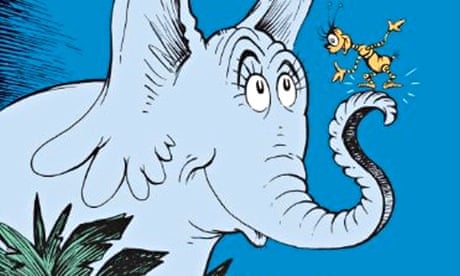A smooth-talking Grinch and a new adventure for the helpful elephant Horton feature in four largely forgotten Dr Seuss stories that will be collected for the first time this autumn.
Horton and the Kwuggerbug and More Lost Stories, out from Random House Books for Young Readers in September, brings together four of Seuss's little-known tales which were published in Redbook magazine in the 1950s, but never released as picture books. In the title story, which dates to 1951, Horton – previously known for his efforts to rescue the Whos – is tricked into helping a tiny, insecty sort of creature who promises him: "I know of a Beezlenut tree where some Beezlenuts grow". Horton takes the Kwuggerbug across a river and up a mountain, "while the Kwuggerbug perched on his trunk all the time / And kept yelling 'Climb! You dumb elephant, Climb'".
In 1955's The Hoobub and the Grinch, the titular Grinch is just as much of a con artist as Seuss's later, more famous, Christmas-stealing version. He tells the gullible Hoobub, relaxing in the sun, that a piece of string is worth far more than the "dangerous" sun. "When the sun gets too hot, it can broil you like fat! But this piece of green string, sir, will NEVER do that! This piece of green string is colossal! Immense! And, to you … well, I'll sell it for 98 cents!"
The collection, which will come with an introduction from Seuss expert Charles D Cohen, is completed with two stories which date from 1950. Marco Comes Late returns to a character Seuss introduced in his 1937 debut And to Think That I Saw It on Mulberry Street in 1937, with Marco trying to explain why he is late for school. How Officer Pat Saved the Whole Town recounts how disaster on Mulberry Street is narrowly averted. "For the most part, those magazines were tossed out when the next month's issue arrived and the stories were largely forgotten," writes Cohen in his introduction, reported USA Today, calling the stories "fresh encounters with old friends and familiar places".
An early review from Kirkus said that all of the stories "involve a certain amount of sharp dealing", and that each "features bright, crisply-reproduced renditions of its original illustrations" as well as "predictably engaging wordplay – 'He climbed. He grew dizzy. His ankles grew numb. / But he climbed and he climbed and he clum and he clum.'"
Another early write-up, from Publishers Weekly, found that the stories were "by no means gems", but do "suggest how Geisel tinkered with characters, developed his signature tetrameter, and commented on ethical issues, circa 1950".
Seuss, real name Theodor Seuss Geisel, was the author of some of the 20th century's best loved children's books, from The Cat in the Hat to Horton Hears a Who. The new collection from an author who died in 1991, aged 87, follows 2011's The Bippolo Seed, another collection of "lost" stories from magazines. Random House said the forthcoming collection, boasting "a colour palette enhanced beyond that of the magazines in which the stories originally appeared", would allow fans to "learn more about Horton's integrity, Marco's amazing imagination [and] a devious Grinch".

Comments (…)
Sign in or create your Guardian account to join the discussion